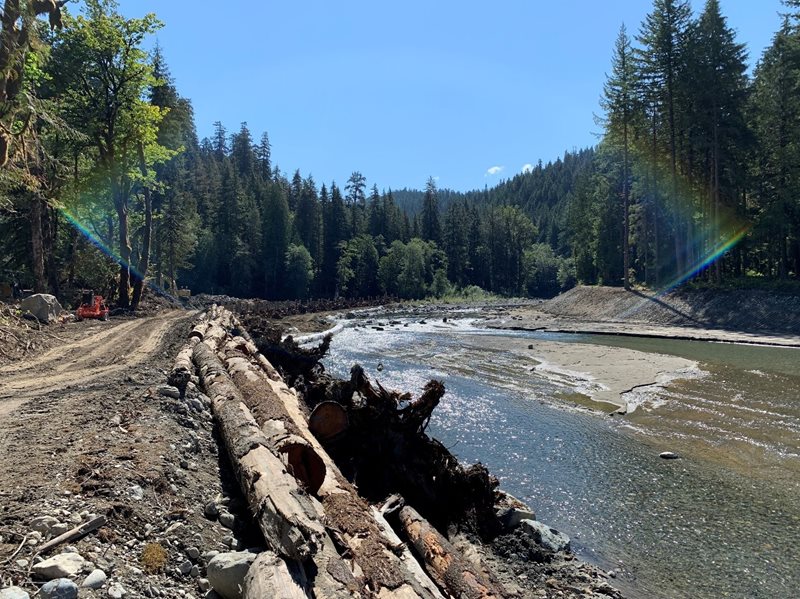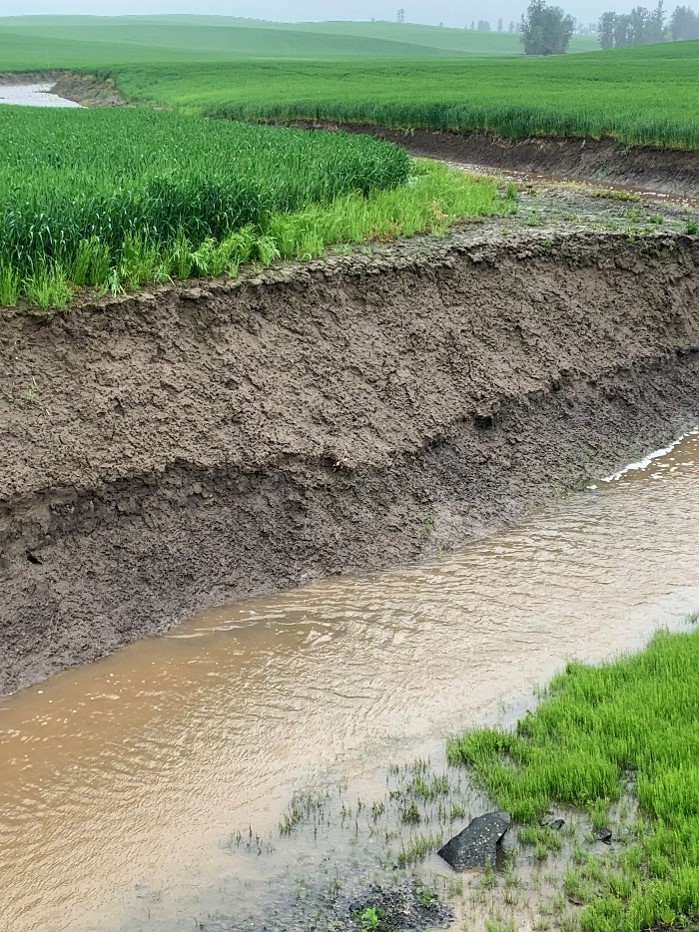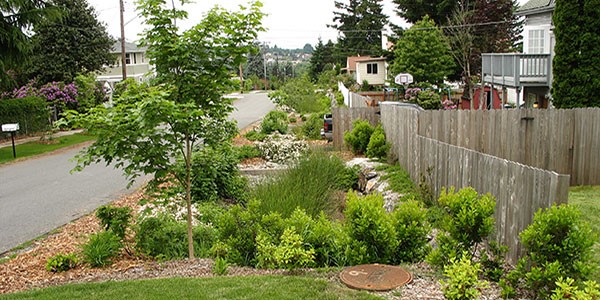
The Stillaguamish Tribe redirected a portion of the South Fork Stillaguamish River to avoid a high-volume landslide area, a major source of sediment. We provided supplemental funding for this complex, large-scale project.
We're proposing to award $303 million in grants and loans for 114 high-priority clean water projects across the state. Our Water Quality Combined Funding program supports communities by helping them upgrade wastewater treatment and sewer systems, manage polluted stormwater, and complete a variety of other projects to prevent and clean up diffuse sources of pollution, also known as nonpoint pollution.
In 2021, President Biden signed the Bipartisan Infrastructure Law and reauthorized the Capitalization Grant, which contributes funding for the Clean Water State Revolving Fund. For state fiscal year 2024, this includes approximately $31 million in BIL supplemental funding focused on assisting small, financially disadvantaged communities and $1.6 million of forgivable-principal loan funding to address emerging contaminants, such as 6PPD. This chemical was recently identified as a significant pollutant contributing to salmon mortality. Forgivable-principal loans do not have to be repaid. Additionally, EPA is providing an estimated $2 million from the Sewer Overflow and Stormwater Reuse municipal grants program, which we are including in the Water Quality Combined Funding program.
Nearly 90% of the funding the Water Quality Program receives is passed through to local communities for environmental and infrastructure projects. Our clean-water funding comes from a mix of state and federal funds dedicated for water quality improvements and protection. State financial managers calculate that 11 direct and indirect jobs are created in Washington for every $1 million spent on building clean-water infrastructure. That means this round of grants and loans could result in over 3,000 jobs.
Potential clean water project highlights
Wastewater
Thirty-four wastewater projects are proposed to receive approximately $207 million in grants, low-interest loans, and forgivable loans. Sixteen of the projects qualify for special hardship assistance, in order to ensure they will not overly increase the sewer bills for residents in these small, financially challenged communities. This type of funding is a top priority of the new federal funding. In addition, one project will refinance a high-interest-rate loan for a small, lower-income community; refinancing existing sewer debt has helped to substantially improve the financial condition of wastewater funds in these communities. The two highest-ranked wastewater projects are:
Valley View Sewer District is on the list to receive $442,532 in low-interest loans and $5 million of forgivable-principal loans to expand sewer service to 59 homes, including an assisted-living center, that currently have failing septic systems. The project will address known bacteria issues in the 303(d) listed Miller Creek watershed.
The City of Pasco is undertaking multi-phase upgrades to the wastewater-treatment plant to maintain and enhance treatment capabilities and to improve energy efficiency.
The City of Pasco is receiving an offer of a $191,860 forgivable-principal loan and a $32 million low-interest loan to improve the municipal wastewater-treatment facility by replacing components of the plant that have exceeded their useful life. The City of Pasco plans to make improvements to their solids handling and UV-disinfection systems, as well as to replace their outfall into the Columbia River. The treatment plant improvements incorporate energy efficiency through optimized equipment sizing/operations and alternative design mechanisms. For the outfall replacement component of this project, a new 42-inch diameter outfall pipe with multiport diffuser will be constructed within the Columbia River. The project also includes removal of the existing 24-inch diameter outfall pipe originally constructed in 1954 and restoration of permanent riparian buffer along the banks of the Columbia River within the project footprint.
Nonpoint
Thirty projects are set to receive a total of $25.8 million in grants to address nonpoint pollution, including that from onsite sewage systems. Nonpoint pollution has a significant impact on water quality; it comes from diffuse sources instead of an identifiable pipe. The two highest-ranked nonpoint projects are:
The Spokane Conservation District will use funding for bioengineering and revegetation to reduce sediment loading into stream channels in the Hangman watershed.
The Spokane Conservation District is set to receive a $424,000 grant to continue critical streambank-stabilization and floodplain-restoration work within the Hangman Creek watershed. These projects will help implement our 2018 settlement agreement with the Spokane Riverkeeper.
Jefferson County Public Health is proposed to receive a $500,000 grant, $7.5 million loan, and $2.5 million in forgivable-principal loans to establish a watershed-conservation fund, providing a scalable loan fund for acquisition of land critical to improving water quality in high-priority watersheds. This innovative program will provide nimble funding, so nonprofit land trusts and other public entities can purchase properties for conservation and sustainable stewardship as land comes available, rather than being tied to the government funding cycle. This pilot project will complete a feasibility assessment, program design, and purchase of two properties to establish the program.
Stormwater
Forty-six communities and port districts will split $53 million in grants, low-interest loans, and forgivable loans to implement projects to manage and reduce stormwater pollution. The two highest-ranked stormwater projects are:
The City of Ferndale is proposed to receive $1.3 million to improve water quality in Schell Creek through the installation of stormwater filters and infiltration trenches, along with curbs and gutters to convey the stormwater. This project will provide treatment for total suspended solids (TSS), dissolved zinc, and dissolved copper for approximately 1.72 acres of previously untreated pollution-generating surfaces from Ferndale Terrace between Hendrickson Avenue and Vista Drive in the City of Ferndale. Stormwater from the Ferndale Terrace project area discharges to Schell Ditch and Schell Creek, which flow to the Lummi (Red) River and Lummi Bay in the Salish Sea. Ferndale Terrace was chosen for this stormwater retrofit because it is classified as an urban major collector serving Seamount and adjacent neighborhoods, with a higher level of benefit associated with treating roads with higher traffic counts. Schell Creek has recently been selected as the high-priority basin for the City of Ferndale Stormwater Management Action Plan.
Seattle Public Utilities is set to receive $3 million of forgivable principal and $8.9 million of low-interest loans to help protect Thornton Creek, a salmon-bearing urban creek. The South Thornton Natural Drainage System project is comprised of five sites and will construct 36 bioretention cells to manage a total of 13.9 acres of impervious area. The project will treat an estimated nine million gallons of stormwater runoff per year, reducing the discharge of pollutants typically found in stormwater runoff, such as copper, zinc, 6PPD-quinone, PCBs, pesticides, total suspended solids, and fecal coliform, among others.
This a natural drainage system a few years after installation, provided by Seattle Public Utilities. This system reduces the pollution in stormwater before it goes into local rivers and streams.
We want to hear from you
We are holding a public comment period on the draft offer list until March 2. Please submit public comments via our online comment form, eComments.
If you have questions, please contact Eliza Keeley-Arnold at eliza.keeley-arnold@ecy.wa.gov or 360-628-1976, or attend the public meeting we are holding at 1 p.m., Feb. 8, via Zoom.
We will respond to all comments received during the comment period and notify all commenters when we publish our final funding list. The final funding list is expected to be published in June.
The funding levels are estimates and may change based on the Washington State Legislature's final 2023-25 Biennial Budget. If the final funding for any of the programs is greater than the amounts estimated, we will offer the additional funds to eligible projects in ranked priority order. If the final funding for any of the programs is less than the amounts estimated, we will reduce the funding offers in reverse-ranked priority order. In addition, public comments and possible changes in projects may affect the amounts and projects proposed for funding.
More information
For more information, including access to an interactive map of funded projects and access to the draft list, please visit the Water Quality Combined Funding program funding cycles webpage.




